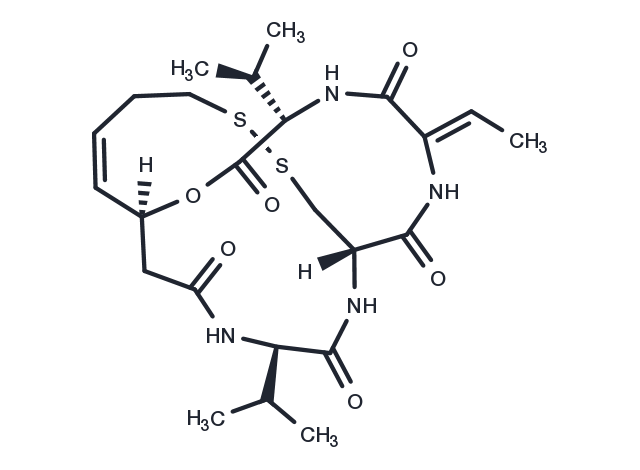Powder: -20°C for 3 years | In solvent: -80°C for 1 year


Romidepsin (FR 901228) is an HDAC inhibitor that inhibits HDAC1/2/4/6 (IC50=36/47/510/1400 nM). Romidepsin has antitumor activity and can be used for the treatment of peripheral T-cell lymphoma and cutaneous T-cell lymphoma.

| Pack Size | Availability | Price/USD | Quantity |
|---|---|---|---|
| 1 mg | In stock | $ 98.00 | |
| 2 mg | In stock | $ 154.00 | |
| 5 mg | In stock | $ 249.00 | |
| 10 mg | In stock | $ 449.00 | |
| 25 mg | In stock | $ 648.00 | |
| 50 mg | In stock | $ 922.00 | |
| 100 mg | In stock | $ 1,250.00 |






| Description | Romidepsin (FR 901228) is an HDAC inhibitor that inhibits HDAC1/2/4/6 (IC50=36/47/510/1400 nM). Romidepsin has antitumor activity and can be used for the treatment of peripheral T-cell lymphoma and cutaneous T-cell lymphoma. |
| Targets&IC50 | HDAC1:36 nM, HDAC2:47 nM |
| In vitro |
METHODS: Two malignant T cell lines, PEER and SUPT1, were treated with Romidepsin (2.5-40 nM) for 48 h. Cell viability was measured by MTT Assay. RESULTS: Romidepsin inhibited the cell viability of PEER and SUPT1 with IC50 values of 10.8 nM and 7.9 nM. [1] METHODS: CD20+ rituximab-sensitive cells, Raji cells and drug-resistant cells, Raji-2R and Raji-4RH, were treated with Romidepsin (10 ng/mL) for 2 days, and intracellular caspase 3 activation level was detected by Flow Cytometry. RESULTS: Romidepsin increased active caspase 3 in Raji cells. cleaved active caspase 3 was not detected in Raji-2R and Raji-4RH. [2] |
| In vivo |
METHODS: To assay anti-tumor activity in vivo, Romidepsin (4.4 mg/kg) was intraperitoneally injected once a week for three weeks into NSG mice harboring human Burkitt's lymphomas Raji and Raji-2R. RESULTS: Romidepsin significantly inhibited the growth of Raji and Raji-2R cells in xenograft mice. [2] METHODS: To detect anti-tumor activity in vivo, Romidepsin (0.03 mg/mouse, 0.5% methylcellulose) was intraperitoneally injected into DEN-induced hepatocellular carcinoma in C56BL/6 mice twice a week for three weeks. RESULTS: Romidepsin inhibited tumor progression, an effect that was associated with decreased tumor cell proliferation and increased apoptosis. [3] |
| Kinase Assay | HDAC-inhibitory activity: For the enzyme assay, 10 μL of [3H]acetyl-labeled histones (25,000 cpm/10 μg) are added to 90 μL of the HDAC enzyme fraction extracted from 293T cells overexpressing HDAC1 or HDAC2 in the presence of increasing concentrations of Romidepsin, and the mixture is incubated at 37 °C for 15 minutes. The enzyme reaction is linear for at least 1 hour. The reaction is stopped by the addition of 10 μL of concentrated HCl. The released [3H]acetic acid is extracted with 1 mL of ethylacetate, and 0.9 mL of the solvent layer is taken into 5 mL of aqueous counting scintillant II solution for determination of radioactivity. The IC50 values are determined from at least three independent dose-response curves. |
| Cell Research | Cells are exposed to various concentrations of Romidepsin for 72 hours in 96-well plates. 20 μL of 5 mg/mL MTT solution in PBS is added to each well for 4 hours. After removal of the medium, 170 μL of DMSO is added to each well to dissolve the formazan crystals. The absorbance at 540 nm is determined. In addition, cells are incubated with trypan blue, and the numbers of blue (dead) cells and transparent (live) cells are counted in a hemocytometer. For cell cycle analysis, cells are incubated for 30 minutes in propidium iodide staining solution containing 0.05 mg/mL propidium iodide, 1 mM EDTA, 0.1% Triton X-100, and 1 mg/mL RNase A in PBS. The suspension is then passed through a nylon mesh filter and analyzed on a Becton Dickinson FACScan. (Only for Reference) |
| Synonyms | FR 901228, FK 228, Depsipeptide, NSC 630176 |
| Molecular Weight | 540.7 |
| Formula | C24H36N4O6S2 |
| CAS No. | 128517-07-7 |
Powder: -20°C for 3 years | In solvent: -80°C for 1 year
DMSO: 100 mg/mL (184.9 mM)
You can also refer to dose conversion for different animals. More
bottom
Please see Inhibitor Handling Instructions for more frequently ask questions. Topics include: how to prepare stock solutions, how to store products, and cautions on cell-based assays & animal experiments, etc.
Romidepsin 128517-07-7 Apoptosis Chromatin/Epigenetic DNA Damage/DNA Repair HDAC FR-901228 NSC-630176 FR 901228 Histone deacetylases FK228 FK 228 Depsipeptide NSC630176 Inhibitor inhibit FK-228 NSC 630176 FR901228 inhibitor
